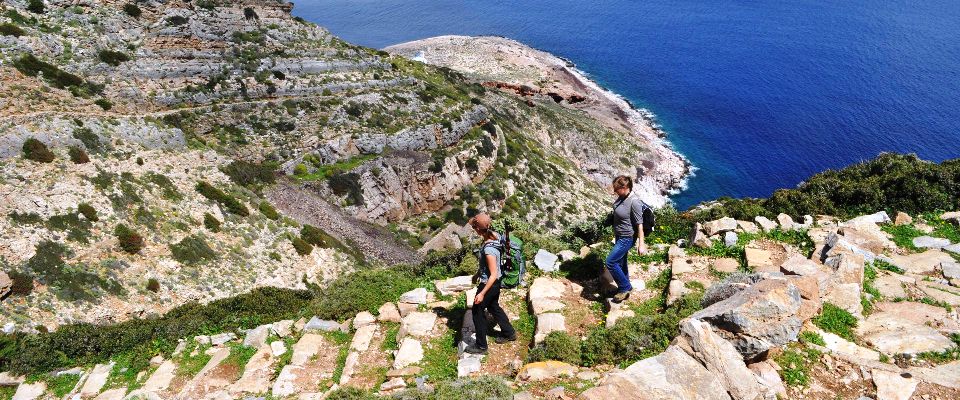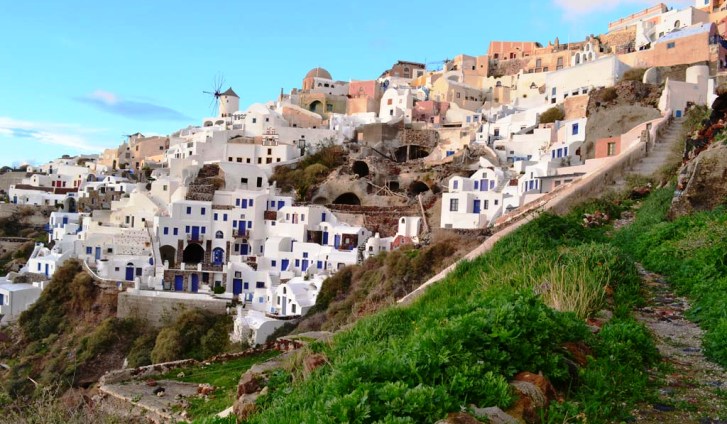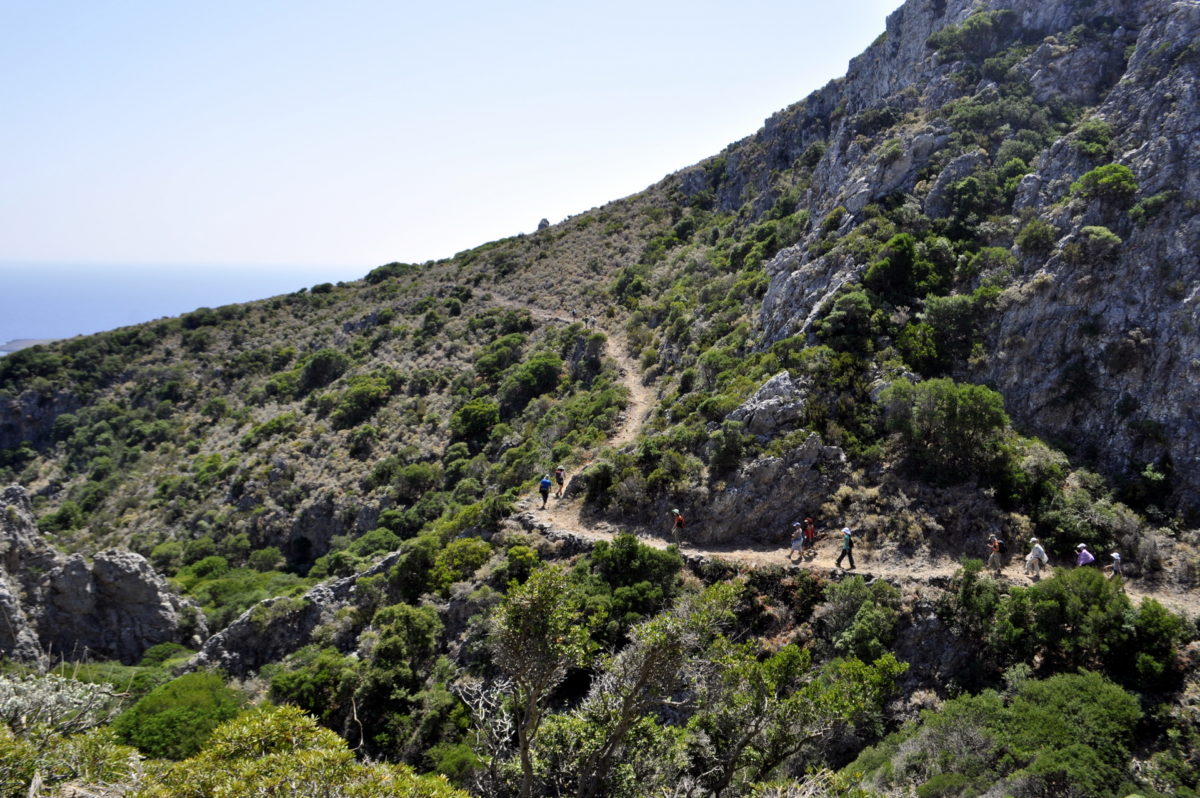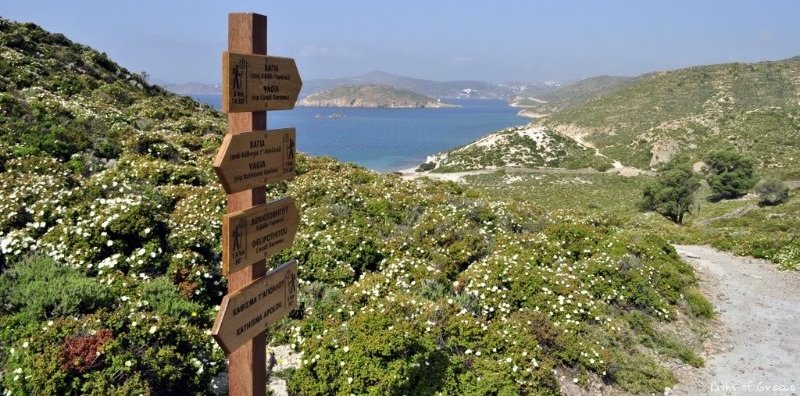The Greek islands, well known for their sunny beaches and clear blue waters, attract outdoor enthusiasts not only for activities such as diving, scuba diving, snorkeling, wind surfing, sailing or just sun bathing, but also for hiking and walking tours! Walking tourism has been gaining ground in the past few years, thanks to public and private initiatives sign-posting routes, publishing maps, organizing walking tours and operating special sites to inform people about available paths and walking tours. This form of tourism is particularly well suited to the Greek islands due to their mountainous morphology and stunning vistas to the endless blue. But there is more to explore; walking tours often include stops at archeological sites, spots of geological, natural, or architectural interest, deserted villages, wineries, artist’s galleries and more!
History of hiking trails on Greek islands
Directly connected to human activity from ancient times, paths crossing areas of high aesthetic and cultural value are nowadays central to alternative tourism activities in Greece. Hiking trails in the country are witness to its long history, rich culture and biodiversity. These paths «betray» uninterrupted human presence through thousands of years. They were formed by pedestrians and animals, mostly horses and donkeys that carried food and other materials from one place to another. These paths were the only land roads to facilitate communication and transport in times of peace and war. They connected cities to harbors, villages to watermills, inns, bridges, churches and monasteries.
Nowadays, the practical importance of these pathways has been significantly reduced, but they have found their new role in the context of the development of regional ecotourism. Old walking paths lined with herbs, offering their unique scents, run along island land; uphill, downhill or through ravines. The sea views from the hills unfailingly entrance hikers: Andros, Aegina, Sifnos, Evia, Tinos, Rhodes, Amorgos, Kea, Santorini, Kythnos, Kethyra, Kefalonia, Patmos, Skiros and Ios, to cite just a few Islands, all offer numerous walks, hikes and strolls, paths and routes.
Andros – An island made for walking
Lush green valleys, flowing rivers, beautiful beaches and ancient pathways compose the landscape of Andros. Andros Route is a continuous exciting hiking route extending from north to south. It is a continuous 100KM cross Andros track with a European Quality certification. It crisscrosses the mountain ranges of the island, passing by it most beautiful natural landscapes and important monuments. One can hike along this route and stay the night on different villages of the island enjoying the unique flavors and particularities of each area. Andros Route, on October 2015 got the distinguished European Quality Certification Leading Quality Trails-Best of Europe managed by the European Ramblers Association establishing Andros as one of the Leading Quality Trails – Best of Europe.
Aegina – Discover paths of culture
Visitors to Aegina have the opportunity to learn the island’s history, to admire the beautiful landscapes and to taste local products, through a network of 9 hiking and cycling routes. They can choose among the Aphaia Temple path, the Mountain Ellanion path, the Sfentouri – Eleonas path, the Eleonas (Ancient Οlive Grove) path, the Chrysoleontissa path, the East of Aegina path, the Mythical Asopοs path, or follow the hiking paths in Paleachora, the island’s former capital (9th– 19th century A.D.) and explore this deserted “ghost town”, also known as the “Island Mystras” with its numerous Byzantine churches or take the Bicycle Ride in the woods.
Sifnos – The footpaths, a unique network of trails, some 200 km in all
Sifnos’footpaths is a unique network of trails some 200 kilometres in all, created especially to meet the needs of the agricultural way of life and the tending of livestock. Sifnos’ footpaths were in daily use, and the oldest have a history dating back as far as the 3rd millennium BC. Nowadays, they still lead the winding way to churches, beaches, through wonderful landscapes, used by local people and visiting hikers alike. Some of them are paved with stone or marble, and others are dirt tracks. On every trail, the hiker will encounter monasteries and churches, as well as artifacts that are monuments to the craft skills of the past, including wells, spring water fountains, dovecotes, ‘the monies’ (small farm buildings), ancient towers, remnants of mining activity, threshing floors, lime-kilns, mills, and stretches of drystone wall kilometers long. Βest times for hiking in Sifnos are spring and autumn. Herbs, cedars, undergrowth and wild flowers, some of which are protected, are to be seen along every trail, and have placed Sifnos among the 13 most important botanical paradises in Greece. The foot paths are well-signposted and properly mapped. Today there are 19 officially marked trails which visitors can view online, and hiking maps are available on the island.

Evia – Tracking a Dragon
Meet one of the oldest ecosystems on earth on Mount Ochi in southern Evia dominating Karystos Town. The large trekking path network reveals under the radar gems such as unique geology, archaeological sites and monuments, a centenarian chestnut tree forest (at Kastanologgos) as well as the impressive Drakospito of Ochi (an archaeological mystery). The main path begins at Myloi Karystou heading towards the refuge located at 1100m altitude. At this point the marked trail will lead you to the top through some steep bare mountainsides. Make a stop at the rock-carved Prophitis Ilias Chapel and drink in the breathtaking view. At a stone’s throw away visit the age-old “Cyclopean” structure known as Drakospito of Ochi. Other suggested trekking trails include: Petrokanalo – Dimosari’s Gorge, Paths of Archampoli’s coast, Centre of Environmental information – Agia Triada – Castello Rosso – Myloi, Platanistos – Helleniko – Potami beach.
Tinos Island – Nature Pilgrimage
Tinos Island, also known as the island of the Virgin Mary, is renowned for its pilgrim traditions. The island boasts unique architecture and rich cultural heritage in the hinterland. Visit traditional villages through cobblestone paths that reach 400km in length. The cliffs are adorned by remote dovecotes and old watermills, terraces and stone walls, chapels and shrines, granite boulders and castle ruins all with a spectacular sea view. Discover more paths: Monastery of Kechrovouni – Exomvourgo, Falatados – Livadas Bay, Myrsini – Prophet Ilias – Tsiknias, Kardiani – Isternia – Pyrgos, Falatados – Volax – Agapi.
Rhodes Island – Cosmopolitan trails
Rhodes Island, the capital of the Dodecanese, has a cosmopolitan aura and beautiful beaches. If you are a trekking lover this is where you will discover countless monuments, important cultural artifacts, pristine villages and forests. Dominating the island’s mountainous backbone is Mount Anavyros, where you can explore it’s demanding alpine paths (suitable for trained hikers). If you are a less experienced hiker you can follow two different trails beginning from Nymphi Springs that lead to Profitis Ilias Chapel and enjoy nature’s beauties. The first path heads directly to the chapel where the second one goes through the Butterfly Valley. For other suggested trekking trails: from the peak of Filerimos cliff in Trianta follow a two hours path through a pine forest ending up at the seashore; from Salakos Village up to the chapel of Agiou Nikolaou Fountoukli enjoy a 4-5 hours walk, on a moderate level of difficulty trail, through a shady forest and olive groves; from Kritinia walk up to the Castle (the best preserved crusader castle of the Knight Hospitallers on Rhodes Island), a perfect sunset-gazing spot; from Vlyha to Lindos; from Anchangelos to the Monastery of Panagia Tsambika; from Koskinou Village to Thermes Kalitheas.
Amorgos – Hiking with a sea view
The wild beauty of this island, with its clear waters and views of endless blue invites hikers to its picturesque shores, accessible via the various island trails. The wonderful landscape of Amorgos with its close-to-the-sea mountains invites you to walk, hike and enjoy both the rich flora and phantastic views at nearly every corner. You don’t need to be a mountaineer to experience the islands secrets and to discover the rich world of Amorgian herbs. With regard to hiking, there are still a couple of very old paths at Amorgos: you can hike from Katapola to Chora or to Minoa, but the queen’s hike is the longer trip on the mountain ridge of the island, from Chora to Egiali. Also the hikes from Egiali and from Arkesini and Kamari are truly wonderful. In addition, some of these hikes are clearly signposted.
Kea – Exciting hiking trails
Kea (also called “Tzia”) is an easily accessible beauty with scenic variety: steep mountains, small fields, olive groves, vineyards, valleys, picturesque coves, exciting hiking trails and off-the-beaten-track beaches. On the island with the largest oak forest in the Cyclades, bird-watching is a real delight. For those who are into geology, there are plenty of small caves (as in Kálamos and in Áyios Timótheos). The 36 km long cobbled trails will lead you to the four city-states of antiquity: Ioulis, Karthaia, Koressia, Poiessa).
Santorini – You won’t truly know the island unless you walk its streets, alleys and fields!
Walking along the caldera will surely be the most scenic route on the island of Santorini. In fact, there is a hiking path that lines up half of the volcanic caldera, from Fira up to Oia via Firostefani and Imerovigli. This hiking trail offers gorgeous views to the famous volcano and the Aegean Sea and also allows visitors to see the four most important villages of the island. This 10 km hike is easy to follow and takes about 3-4 hours. Starting from the centre of Fira (also known as Thira), the capital of the island, hikers pass the Orthodox Metropolitan Church, the Catholic Cathedral and the main shopping street of Fira, heading to the north. On the left lies the Aegean Sea and the volcano, so you will surely make many stops for photographs. Next village is Firostefani, which has actually become a continuation of Fira, with the hotels and houses of two villages almost attached.
Mot hikers stop at this point, but if the weather is not too hot, we suggest you continue with the rest of the route, as you will find some truly gorgeous spots along your way.Following the inland road through Firostefani, hikers shall pass the Monastery of Saint Nicolas, founded in the 17th century and hosting important Byzantine icons. Continue through Imerovigli, a truly picturesque village, much less busy than Fira. If you are feeling adventurous, hike up to the famous Skaros Rock to get the most breathtaking sea view. Continuing to the north, hikers shall pass the Church of Agios Antonios (Saint Antony) and the Church of Prophet Elias, both worth a short stop to see the stunning view over to Thirassia island and the wild caldera cliff. Oia will be seen after few steps from these two churches.Suggested hiking time is the afternoon: start from Fira early in the afternoon to arrive in Oia at sunset time. This well known Santorini hiking path from Fira to Oia, occasionally leads into the main street and then again enters the villages. The local municipality is planning to create a paved path along the caldera, exclusively for hikers.

Kythnos – Hiking with tranquility
If you are looking for tranquility, simplicity and authenticity, yet at the same time wish to combine your summer holidays with some walking, hiking and interesting cultural encounters, the secluded island of Kythnos is your perfect choice! Although it is one of the first islands to be reached by ferry from Athens, the island of Kythnos has remained an unexplored paradise, a true gem of the Cyclades islands. Traditional villages with Cycladic architecture, a superb coastline with more than 90 beaches, a significant history dating back to the Mesolithic era, agricultural fields, hot springs, numerous hiking trails, one of the largest caves in Greece (considered to cover an area of 3.500 sq.m.) and the delicious local cuisine will undoubtedly offer you active holidays on a Greek island. Follow the hiking trail from Dryopida village, one of the most picturesque and traditional settlements of Kythnos and it will soon take you to the beautiful beach of Lefkes. Then, get ready to explore Katafiki cave, one of the largest caves in Greece, most of which remains unexplored to date. Located at the edge of Dryopida village, at an altitude of 190 meters above sea level, the cave maintains a constant temperature of 17 degrees.
Kythera – Walking the Paths of Venus
Since October 2010, a team of experts devoted to the development of hiking trails networks under the name “Paths of Greece”, have been working on the project of the Paths of Kythera and Antikythera islands, called Kythera Hiking. It is an inclusive project of path network development, including environmental education actions for school kids of Kythera. Visit the official website of the project www.kytherahiking.com for more information about Coastal trails, Easy trails, Kids friendly trails, long trails, Loop, Short trails or Swim.

Patmos – Scenic panorama of island life
Patmos possesses a rich network of old footpaths, which join the various settlements with one another and with the Monastery, as well as with the island’s many monastic establishments and hermitages. ELLINIKI ETAIRIA – Society for the Environment and Cultural Heritage, in collaboration with the Municipality of Patmos and with the active involvement of the island’s schools, is implementing the project “Paths of Culture”, by carefully selecting and signposting a series of walks, thus giving visitors the opportunity to discover the island’s natural beauty and monuments in a healthy and eco-friendly way. Thus far, 7 trails have been signposted: Skala – Chora – Skala, Aporthianos, the Archaeological site of Kastelli , Chora – Grikos – Diakofti , Chora – Kipoi – Holy Monastery of Annunciation, Stavros – Prasovouno – Psili Ammos , Vaghia and Chora – Profitis Ilias.
Skyros – Paths developed to promote and conserve the islands’ biodiversity
On the beautiful island of Skyros, in the framework of the LIFE programme “Demonstration of the Biodiversity Action Planning approach, to benefit local biodiversity on an Aegean island – Skyros”, run, amongst others, by the Hellenic Society for the Environment and Cultural Heritage, “Paths of Greece” undertook to study, develop and signpost hiking trails. Skyros is one of the most important islands for biodiversity conservation, especially for bird wildlife. The paths of Skyros help in the promotion and conservation of this natural heritage.
Ios – Donkey steps
Ios acquired a full travelogue network of hiking paths through picturesque beaches, churches, archaeological sites, etc. The restoration of this network was completed by a group of volunteers of the Greek Cultural Mountaineering Club of Fyli, in its long quest for the emergence of old paths. After their recovery from the team of volunteers of the Club, the view of the ornate stonework or the carved steps on the already existing rocks was revealed and the passage through them in now unobstructed. Some of these paths are part of the main axis of the old hiking route of Ios, connecting small villages or harbors with the city. Four old trails have been cleared and are now open for hikers with a total length of 13.5 kilometres: 1) from Mylopotas to Sanounochoma and Klima, 2) from Chora to Ag. Spyridon, Perivolia, Ag. Prokopis, Anemogennitries, Ag. Anargyri and Ag.Thedoti 3) from Psathi to Ormos Domino and 4) from Ag. Theodoti to Ormos Avlaki Kastrou. The old trails are connected to other paths and provide Ios with a complete hiking network.
Kefalonia – The paths of Erissos
Working together with the Cultural and Environmental club of Erissos “Asteris”, “Paths of Greece”have completed the sign-posting of a network of hiking trails in Fiskardo. In total, three trails of 850, 4.7 and 10km have been sign-posted. While walking these paths, one can enjoy all the landscapes of the peninsula, as well as discover cultural secrets that no car can access! The Battery Trail, the Lighthouse trail and the Cypress trail have the advantage that they can easily be accessed even in summer, since they are largely covered by dense shade, thanks to the forests of cypresses, pine and of strawberry trees.
Sources: VisitGreece, Paths of Greece, news.travelling.gr, trailsbeyond.gr, greekacom.gr , androsroutes.gr, monopatiapolitismou.gr, sifnos.gr
TAGS: TOURISM















